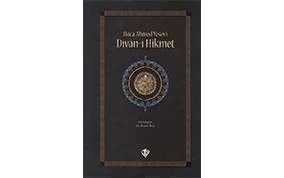Real History of Ahmad Yasawi
Ahmad Yasawi was born in 1093 in the town of Sayram in the east of today's Kazakh city of Shymkent. His real name is Ahmed bin İbrâhim bin Ilyâs Yasawi. After the death of his father when he was 7 years old, Yasawi, who settled in Yesi near Sayram with his sister, started to receive his primary education from a Turkish sheikh named "Arslan Baba".
 |
| Ahmad Yasawi |
After completing the first stage of his education, Yasawi went to Bukhara when he was 27 years old and became a follower of Sheikh Yusuf Hemedani, one of the leading religious scholars of the period. Ahmad Yasawi, who received an intensive Sufism education here, became the third of the four caliphs of the Sheikh and succeeded his Sheikh after the first two caliphs. Later, he left the position of irşad to Sheikh Adülhalik Gücdûvani and returned to Yesi'ye.
He founded the Yasawiye Ocağı in Yesi. Muhammed Bahaüddin Nakşbend, a student of Sheikh Adülhalik Gücdûvani, who he left in Bukhara, became one of the two great sects that emerged outside of the Yasawiye Hearth at that time. The Nakşibendiye order established in Bukhara spread over time to Afghanistan, India and Anatolia.
Ahmad Yasawi, on the other hand, based his teaching on the love of "Ahl-i Bayt" and his understanding of Sufism in this direction, which he received from his teacher Arslan Baba. This first great "Turkish sect" founded by a Turkish Sufi first influenced Transoxiana, Tashkent and its environs and western Turkistan. Later, the Yasawi sect, which spread among the Turks living in Khorasan, Iran, and Azerbaijan, reached Anatolia with migrations starting from the 13th century and from there to the Balkans. Bektashism, Babaism, and Haydarism, which started to be seen in Anatolia in the 13th century, are the branches that came out of the Yesevî sect. Hacı Bektashi Veli, who would later be regarded as Yunus Emre's guide who was sent from the unseen, and Sarı Saltuk, who was also the hero of the religious epic, then Ahi Evren, who was regarded as the priest-master of the Anatolian Ahilik, Şeyh Edebali, the deceased father-in-law of Osman Bey, Geyikli Baba, who was the master of Orhan Gazi. and many more are his followers, raiders and caliphs that Ahmed Yasawi sent to Anatolia for spiritual conquests, told in the form of facts supported by legends.
Hace Ahmet Yesevî, who educated people in terms of religious and moral aspects, explained his Sufi ideas in Turkish and plain poems, and these poems called wisdom were collected over time and Dîvân-ı Hikmet magazines were formed.
 |
| Dîvân-ı Hikmet |
Ahmad Yasawi divided his time into three. He was busy with worshipping and dhikr most of the day. In the second part, he taught his students the inherent and intangible sciences. In the third part, he used to make wooden spoons and sell them to earn a living with his sweat. As understood from the legends about him, Ahmad Yasawi was criticized by some scholars of his time due to the dhikr style in the dervish lodge. In some of his poems, he criticized dishonest scholars and false Sufis. The subjects he mostly covered in his conversations and poems were the love of God and the prophet, protecting the poor and orphans, observing religious rules, good morals, dhikr, fighting with the soul, criticizing oneself (godsend), thinking about death, spiritual ranks and the evil of claiming to be a sheikh without exceeding these levels. were issues.
According to the legend, when Ahmad Yasawi was sixty-three years old, he built a small hankery under the ground in his lodge. He spent most of his life there in worship and contemplation.
Although Ahmad Yasawi had a son named İbrahim, he passed away while he was alive. The generation of Yasawi continued thanks to his daughter named Gevher. As in Turkistan, Transoxiana, and Central Asia, there have been many famous personalities in Anatolia, who regard themselves as descendants of Ahmed Yasawi. Seyh Zekeriyya from Samarkand, Poet Ata from Skopje and Evliya Celebi are some of these names.
Ahmad Yasawi died in Kazakhstan at the age of 73 in 1166
At the end of the century, Emir Timur visited the tomb of Ahmad Yasawi, whose reputation and influence spread widely in the steppes of Turkistan, and ordered a tomb to be built on the tomb, and within a few years, he built a complex with a tomb, mosque and dervish lodge. Today, this tomb is one of the most important places to visit in Central Asia. The fact that there is a distance of about 100 meters between Ahmad Yasawi's çilehânesi and his tomb suggests that his first and main lodge was in the Çilehane region. After his death, when a large complex was built in the place where he was buried, a new and big dervish lodge consisting of a library, soup kitchen, mosque and dervish cells must have come into being.
 |
| Tomb |
Works:
- Divan-i Hikmet
- Fakrname
- Risala der Âdâb-ı Tarîkat
- Risâle der Makâmât-ı Erba‘în



0 Comments